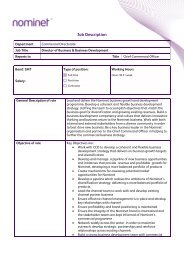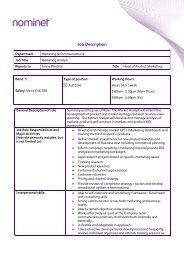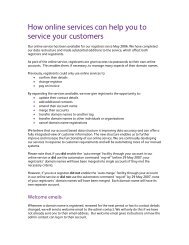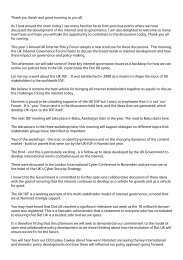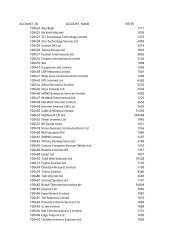voting rights analysis - Nominet
voting rights analysis - Nominet
voting rights analysis - Nominet
Create successful ePaper yourself
Turn your PDF publications into a flip-book with our unique Google optimized e-Paper software.
Members’ <strong>voting</strong> <strong>rights</strong>Analysis and discussion of consultation feedback1. IntroductionA consultation ran from 4 May 2006 to 5 June 2006, concerning the <strong>voting</strong> <strong>rights</strong> of <strong>Nominet</strong>’smembership.The Board asked the membership to consider 4 options, which can be broadly summarised as:1. No change (meaning, votes capped at 10% of possible votes)2. Votes capped at 10% of votes cast (as proposed at the EGM)3. Votes capped at 3% of votes cast; or4. ‘One-member, one-vote’ (which would need a change to the Articles).2. What the respondents said2.1 The general outcomeHow Many Respondents Favoured Each Option (of 30 responses)(Option 1 is from 12 o'clock to 1 o'clock with the rest clockwise from there)20%10%3%67%1 - 10% of Possible Vote2- 10% of Actual Vote3 - 3% (or 4%) of Actual Vote4 - One Member, One Vote (OMOV)The formal responses are analysed above. Two responses favoured Option 1.There was only one response in favour of Option 2.Option 3 was the most popular with 20 responses in favour (including 5 responses who wantedOption 3 but with 4%). This option was also the most popular in the views expressed at<strong>Nominet</strong> events and meetings.There was some criticism of Option 3, one member in their formal response said that “none ofthe other options [apart from Option 1]” met the requirement of “[Reflecting] the commercialinvolvement of the member in the .uk name space.” Others expressed a view that the reduction inthe cap need not apply to all member votes.1
Option 4 was also popular, with 7 in support, because it was perceived to protect <strong>Nominet</strong> fromcapture and to be fair. It was also supported by one response which favoured Option 3 as astaging post towards the goal of OMOV.2.2 Non-linear <strong>voting</strong>There was some support for non-linear <strong>voting</strong>, which would most likely be achieved by allocating<strong>voting</strong> <strong>rights</strong> in line with the square root of domains registered. This would both mean that,although <strong>rights</strong> would increase in line with registrations, the number of registrations required toincrease <strong>rights</strong> would themselves become huge.In reviewing this suggestion, we analysed how <strong>voting</strong> allocations would be affected. There aretwo potential areas of concern.• It is less transparent than Option 3. Without access to the total number of domainregistrations per member, it is impossible to work out the equal votes. Options 2 and 3are written so members could easily calculate their own <strong>voting</strong> <strong>rights</strong>, making the processmore transparent. There is concern that this proposal would complicate the calculationand promote suspicion rather than increase trust.• It is more dependent on whether “connected” memberships have been properly linkedthan the current system, which increases the complexity of operational implementation.2.3 The largest votersDue to merger there are now two main ‘large’ <strong>voting</strong> blocks. We had a response from both.One supported Option 1 and one supported Option 2. One of these members also asked thatconsultation responses be weighted in view of the <strong>voting</strong> power of the member concerned togive a fair result to all members.2.4 Implications of raising the cap to 4%A number of other responses suggested raising the cap to 4%. To raise the cap to 4% wouldlessen the impact of the changes on the largest members slightly, whilst still protecting <strong>Nominet</strong>from capture by a single party.3. ConclusionThe majority of responses favoured Option 3. The two largest members wanted a higher cap,and one asked us to weight consultation responses to reflect <strong>voting</strong> power. A number of otherresponses suggested raising the cap to 4%. Others suggested the cap need not apply to allmember votes.After considering the consultation responses carefully, the Board has changed the <strong>voting</strong> <strong>rights</strong>as follows:• votes capped at 10% of votes cast for changes to <strong>Nominet</strong>’s Articles of Association(requiring a 75% majority),• and votes capped at 3% of votes cast for all other weighted votes, including election ofnon-executive Directors and changes to <strong>Nominet</strong>’s Memorandum of Association.This takes into account the majority wish for a 3% cap on votes cast, yet also responds to theconcerns of some of the larger members.2
The changes will mean that at least 4 members are required to block a vote requiring a 90%majority (i.e. a vote on changes to the Memorandum of Association) and at least 3 members arerequired to block a vote requiring a 75% majority (i.e. a vote on changes to the Articles ofAssociation).The wording of the bylaw has been altered to reflect these changes.The new <strong>voting</strong> <strong>rights</strong> take immediate effect and are published athttp://www.nominet.org.uk/governance/<strong>voting</strong>/policy. The new <strong>voting</strong> <strong>rights</strong> will be used forthe election of non-executive directors at the 2006 Annual General Meeting on 27September 2006.3



